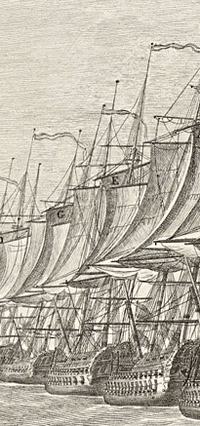Dutch ship Batavier
 The Batavier (E) during the Battle of Dogger Bank on 5 August 1781. | |
| History | |
|---|---|
| Name: | Batavier |
| Launched: | 1779 |
| Commissioned: | 1780 |
| Name: | Batavier |
| Captured: | By the Royal Navy in 1799 |
| Acquired: | 1799 |
| Commissioned: | 1799 |
| Out of service: | 1823 |
| Reclassified: |
|
| Fate: | Broken up in 1823 |
| General characteristics | |
| Class and type: |
|
| Tons burthen: | 1,047 87⁄94 (bm) |
| Length: | |
| Beam: | 40 ft 10 in (12.4 m) |
| Depth of hold: | 16 ft 5 in (5.0 m) |
| Propulsion: | Sails |
| Sail plan: | Full rigged ship |
| Armament: |
|
The Batavier was a Dutch 56-gun fourth rate ship of the line of the navy of the Dutch Republic, the Batavian Republic, and the Royal Navy.
Dutch career and capture
The order to construct the ship was given by the Admiralty of Amsterdam. The ship was commissioned in 1780.[1] On 5 August 1781, the Batavier took part in the Battle of Dogger Bank under Captain Wolter Jan Gerrit Bentinck. The Batavier sailed in the middle of the Dutch line, between the ships Admiraal de Ruyter and Argo. She was attacked by three British ships, and became unmanageable after a fire broke out. Neither the British nor the Dutch were victorious in the battle, and afterwards the Batavier was towed to Texel. Bentinck later died wounds he received in the battle.[2]
In 1795, the ship was commissioned in the Batavian Navy.
On 11 October 1797 the Batavier took part in the Battle of Camperdown under Captain Jan Jacob Souter. Early in the battle, the ship was under heavy fire, but soon she drifted off, and she eventually left the scene and fled to Texel.[3]
On 30 August 1799 the ship was surrendered to the British fleet under Vice-Admiral Andrew Mitchell during the Vlieter Incident, even though the Batavier was the only ship of the Dutch fleet where no mutiny had broken out.[4]
Royal Navy career
The Batavier was sailed to Britain and underwent refitting at Chatham Dockyard between 14 July 1800 and 15 July 1801 for use as a floating battery. She was officially established in February 1801. She was commissioned in June 1801 under Captain William Robert Broughton for service in the English Channel. Broughton was succeeded in April 1803 by Captain Patrick Tonyn, and in August 1804 she was laid up at Chatham. She was moved to Woolwich Dockyard in April 1809, where she functioned as a hospital ship under the command of Lieutenant Thomas Dorsett Birchall. This service lasted until January 1817, after which she was moved to Blackwall to receive distressed seamen. Her final service was to be fitted out at Woolwich as a prison ship. She was based at Sheerness from September 1817, and was finally broken up there in March 1823.[5][6]
Notes
- ↑ "Delpher Kranten - Noordhollandsche courant 05-07-1780". kb.nl. horizontal tab character in
|title=at position 16 (help) - ↑ "Wolter Jan Gerrit Bentinck". regiocanons.nl.
- ↑ Martinus Stuart. Jaarboeken van het Koninkrijk der Nederlanden, deel 2 (Amsterdam: E. Maaskamp, 1797), 1373.
- ↑ L.C. Vonk. Geschiedenis van de landing van het Engelss-Russische leger in Noord-Holland (Haarlem: Francois Bohn, 1801), 58.
- ↑ Winfield. British Warships of the Age of Sail 1793–1817. p. 269.
- ↑ "Sailing Navies: Batavier, 54". sailingnavies.com.
References
- Winfield, Rif (2007). British Warships in the Age of Sail 1793–1817: Design, Construction, Careers and Fates. Seaforth. ISBN 1-86176-246-1.